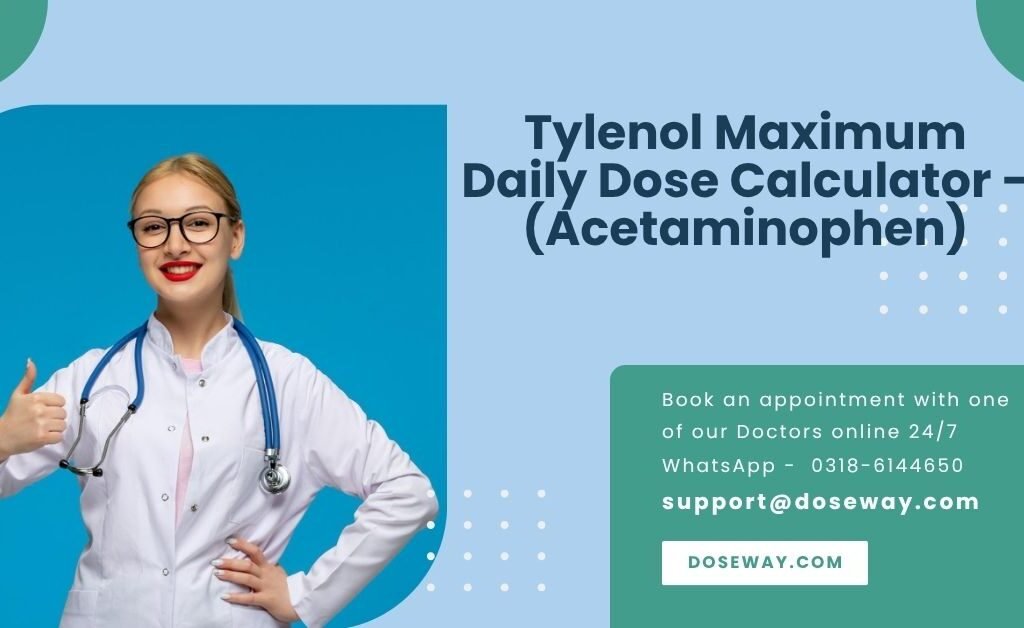Tylenol Maximum Daily Dose Calculator
Calculate safe acetaminophen dosage based on your health profile
Maximum Daily Dose of Acetaminophen
Interpretation
The maximum daily dose of acetaminophen calculated for you is 3,000 mg, which falls within the moderate risk category.
Important: Based on your medical profile (liver disease), your maximum daily dose is lower than the standard 4,000 mg limit.
Standard dosing guidelines:
- Healthy adults: Up to 4,000 mg per day
- Adults with liver concerns: 2,000-3,000 mg per day
- Children: 10-15 mg/kg per dose (not to exceed 5 doses in 24 hours)
Personalized Recommendations
- Do not exceed 3,000 mg of acetaminophen in any 24-hour period
- Space doses at least 4-6 hours apart
- Avoid consuming alcohol while taking acetaminophen
- Check all medication labels for acetaminophen content (many combination products contain it)
- Consult your physician before long-term use
- Monitor for symptoms of liver damage: nausea, vomiting, loss of appetite, abdominal pain, yellowing of skin/eyes
Note: This calculation is based on standard medical guidelines. Individual needs may vary. Report any side effects to your healthcare provider immediately.
Try More Free Tools:
- Try our Pediatric Ibuprofen Dose Calculator (by Weight & Age)
- Try our IVF Success Calculator After Retrieval | IVF Success Rate by Age
- Try our Height And Weight Percentile Calculator (Baby Growth Percentile)

Table Of Contents
Free Tylenol Maximum Daily Dose Calculator – Your Personalized Safety Check
Acetaminophen (Tylenol) hides a dangerous paradox: America’s most trusted pain reliever causes 56,000 emergency room visits annually. Understanding your personal toxicity threshold could prevent irreversible liver damage. Our clinically designed calculator reveals your safe limit in seconds.
Understanding Acetaminophen Pharmacology
Acetaminophen metabolism follows distinct pathways in your liver:
- Primary route: Glucuronidation (55%) and sulfation (30%)
- Toxic pathway: CYP450 enzyme conversion to NAPQI
- Detoxification: Glutathione binding neutralizes toxins
Critical risk factors altering this balance include:
- Chronic alcohol consumption (>3 drinks/day)
- Pre-existing liver conditions (cirrhosis, hepatitis)
- Concomitant CYP450-inducing medications
- Malnutrition or fasting states
Hepatotoxicity Warning Signs
Phase 1: Initial symptoms (0-24 hours)
- Unexplained nausea/vomiting
- Loss of appetite
- Generalized malaise
Phase 2: Latent damage (24-72 hours)
- Right upper quadrant tenderness
- Rising transaminase levels (AST/ALT)
- Decreased urine output
Phase 3: Hepatic crisis (72-96 hours)
- Jaundice (yellowing skin/eyes)
- Confusion/encephalopathy
- Coagulopathy (uncontrolled bleeding)
Diagnostic Evaluation Protocol
Laboratory assessment essentials:
- Acetaminophen blood levels (drawn ≥4h post-ingestion)
- Hepatic function panel (AST, ALT, bilirubin, albumin)
- Coagulation studies (INR, prothrombin time)
- Renal function tests (creatinine, BUN)
- Arterial blood gas (metabolic acidosis detection)
Risk stratification tools:
- Rumack-Matthew nomogram: Predicts hepatotoxicity risk
- King’s College Criteria: Determines transplant eligibility
- MELD Score: Quantifies liver disease severity
Medical Interventions for Overdose
N-acetylcysteine (NAC) protocols:
| Administration Route | Loading Dose | Maintenance Protocol | |----------------------|-------------------|-----------------------------| | Intravenous (IV) | 150mg/kg over 1h | 50mg/kg over 4h → 100mg/kg over 16h | | Oral | 140mg/kg | 70mg/kg every 4h × 17 doses |
Advanced interventions:
- Charcoal hemoperfusion: Toxin removal
- Liver transplant evaluation: When INR >6.5 post-resuscitation
- Molecular adsorbent recirculating system (MARS): Bridge to transplant
Preventive Safety Measures
Medication management principles:
- Daily maximum: Never exceed 4,000mg (healthy adults)
- Dosing intervals: Minimum 4-6 hours between doses
- Combination product awareness: Screen all medications
High-risk population protocols:
| Patient Group | Maximum Daily Dose | Monitoring Requirements |
|---|---|---|
| Chronic alcohol users | 2,000mg | Monthly LFTs |
| Cirrhosis patients | 2,000mg | Pre-dose INR/LFTs |
| Pediatric patients | 75mg/kg/day | Weight-based calculations |
How Our Safety Calculator Protects You
Algorithmic risk assessment:
Safe Dose = Base Limit (4000mg)
- [Liver Disease Penalty (0-2000mg)]
- [Alcohol Modifier (0-1000mg)]
- [Age Adjustment Factor]
Interpretation guide:
- Green Zone (3000-4000mg): Standard risk
- Yellow Zone (2000-3000mg): Moderate risk (medical consultation advised)
- Red Zone (<2000mg): High risk (requires physician supervision)
Calculation methodology sources:
- FDA Acetaminophen Overdose Prevention Initiative
- American Association for the Study of Liver Diseases
- European Medicines Agency Pharmacovigilance
Which medications contain hidden acetaminophen?
1. Prescription opioids: Vicodin®, Percocet® 2. Migraine formulas: Excedrin Migraine® 3. Cold/flu multisymptom relievers: DayQuil®, Theraflu® 4. Sleep aids: Tylenol PM®
Final Safety Recommendations
Establish your personalized threshold using our calculator. Remember that symptoms may not manifest until irreversible damage occurs. When uncertain:
- Consult the calculator before dosing
- Verify combination product ingredients
- Seek immediate care for accidental overconsumption
Disclaimer: This tool provides informational estimates only. Always consult healthcare providers for medical decisions.
Frequently Asked Questions (FAQs) –
What makes acetaminophen toxic?
The metabolite NAPQI accumulates when glutathione reserves deplete, binding irreversibly to liver proteins, causing cellular necrosis.
Why do alcoholics have lower tolerance?
Ethanol induces CYP2E1 enzyme production, accelerating NAPQI generation while depleting glutathione.
Can children overdose more easily?
Pediatric patients have enhanced sulfation capacity, reducing toxicity risk, but dosing errors remain dangerous.

 Cart is empty
Cart is empty
Add a Comment